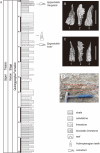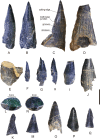First discovery of actinopterygian cutting-edged teeth from the middle Norian (Late Triassic) at the Tulong section, southern Tibet, China
- PMID: 39713153
- PMCID: PMC11662892
- DOI: 10.7717/peerj.18728
First discovery of actinopterygian cutting-edged teeth from the middle Norian (Late Triassic) at the Tulong section, southern Tibet, China
Abstract
Actinopterygians (ray-finned fishes) successfully passed through the Permian-Triassic Mass Extinction (PTME) and flourished in the Triassic with diverse feeding specializations and occupation of various trophic levels. Birgeria, one of the largest actinopterygian fish of the Triassic, was characterized by a strong, blunt rostrum and three rows of sharp cutting-edged teeth, making them the top predators in the Early Mesozoic oceanic ecosystem. These fishes rapidly radiated and diversified globally during the Early and Middle Triassic, but the fossil record is rare for the Neo-Tethys in the Late Triassic. Here, we report new actinopterygian teeth with cutting edges from Norian-age strata in the Tulong section, which was located on the northern margin of the Indian Plate at that time. The tooth features, such as the polished acrodin cap, the ratio of the acrodin cap in length, and the tiny vertical striae at the tooth base, suggest an affinity with Birgeria, which is reported in this region for the first time. Furthermore, we infer that the carnivorous Birgeria, which co-occurred with the enigmatic ichthyosaur Himalayasaurus tibetensis, played the role of predator in this part of the Neo-Tethys marine realm during the Late Triassic. These new findings increase the known diversity of actinopterygians during the Late Triassic and provide further insight into the marine fauna of this epoch.
Keywords: Actinopterygii; Birgeria; Himalayasaurus tibetensis; Qulonggongba formation; Tooth morphology.
© 2024 Fang et al.
Conflict of interest statement
The authors declare that they have no competing interests.
Figures






Similar articles
-
Triassic actinopterygian fishes: the recovery after the end-Permian crisis.Integr Zool. 2014 Aug;9(4):394-411. doi: 10.1111/1749-4877.12077. Integr Zool. 2014. PMID: 24148549
-
Permian-Triassic Osteichthyes (bony fishes): diversity dynamics and body size evolution.Biol Rev Camb Philos Soc. 2016 Feb;91(1):106-47. doi: 10.1111/brv.12161. Epub 2014 Nov 27. Biol Rev Camb Philos Soc. 2016. PMID: 25431138 Review.
-
Phanerozoic survivors: Actinopterygian evolution through the Permo-Triassic and Triassic-Jurassic mass extinction events.Evolution. 2018 Feb;72(2):348-362. doi: 10.1111/evo.13421. Evolution. 2018. PMID: 29315531 Free PMC article.
-
Macropredatory ichthyosaur from the Middle Triassic and the origin of modern trophic networks.Proc Natl Acad Sci U S A. 2013 Jan 22;110(4):1393-7. doi: 10.1073/pnas.1216750110. Epub 2013 Jan 7. Proc Natl Acad Sci U S A. 2013. PMID: 23297200 Free PMC article.
-
Rapid turnover of top predators in African terrestrial faunas around the Permian-Triassic mass extinction.Curr Biol. 2023 Jun 5;33(11):2283-2290.e3. doi: 10.1016/j.cub.2023.04.007. Epub 2023 May 22. Curr Biol. 2023. PMID: 37220743 Review.
References
-
- Agassiz L. Abgerissene Bemerkungen über fossile Fische. Neues Jahrbuch für Mineralogie, Geognosie, Geologie und Petrefaktenkunde. 1834;4:379–390.
-
- Agassiz L. Recherches sur les poissons fossiles, Tome I–V. Neuchâtel: Imprimerie de Petitpierre; 1835–1844. p. 366.
-
- Aldinger H. Über Reste von Birgeria (Pisces, Palaeoniscidae) aus der alpinen Trias. Neues Jahrbuch für Mineralogie, Geologie und Paläontologie, Beilage-Band B. 1931;66:167–181.
-
- An XY, Zhang YJ, Zhu TX, Zhang YC, Yuan DX, Li J. Stable carbon isotope perturbations recorded in Triassic Tulong Group Qulonggongba Formation of South Tibet. Earth Science-Journal of China University of Geosciences. 2020;46(1):2964–2977. (in Chinese, with English abstract)
-
- Beltan L, Freneix S, Janvier P, López-Paulsen O. La faune triasique de la formation de Vitiacua dans la région de Villamontes (Département de Chuquisaca, Bolivie) Neues Jahrbuch für Geologie und Paläontologie Monatshefte. 1987;1987:99–115. doi: 10.1127/njgpm/1987/1987/99. - DOI
MeSH terms
LinkOut - more resources
Full Text Sources
Miscellaneous

